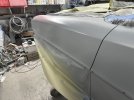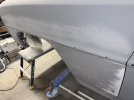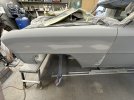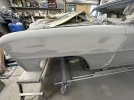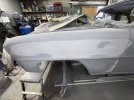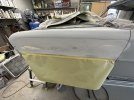Ok I give its my turn now
These waves show up by using the solvent method and sky lighting down the side of panel. Even after applying epoxy I can see them looking at a angle.
OK, I have blocked and blocked several times and appears the same method is not going to work.
I have applied epoxy over bare metal, then filler work with 80 grit then another two coats of epoxy blocked with 120 grit and then another two coats of epoxy and blocked 120 and 150 and still have these real small waves. Yes I used guide coat and it goes away and did that several times.
Note I only have this problem on the fenders not the rest of car. The doors have a similar crown areas but it appears metal is different or thicker. These are original parts too. I am sure someone has run into this before so that's why I am posting.
The fenders have a slight horizontal and vertical crown so to speak and about 3 inches before the molding line it is like a inverted crown that goes in then back out slightly. I am thinking maybe the blocks are riding over the crown in the middle where it drops slightly and causing the issues. Do I need to use a thinner not so wide of block maybe? I have used long and short standard width blocks.
I have been using just epoxy and blocking but I though I would try something different and currently have two coats of epoxy and two coats of Turbo on the fenders as maybe the Turbo will sand easier not take as much pressure etc.
I need some professional advice on this issue so I can move on.
I will post a photo but its not going to show the waves which are only in the middle which is above the wheel opening area and about 2-3 inches above the molding body line. Only way to see waves is a video sighting down the side with wet solvent method etc. Also I think the fender has some transitioning from front to rear so a long block has not worked for me to get the waves out either.
If it was a paint job that had orange peel you would probably be OK but I am going to cut and buff so I want it Don Hutton straight
Maybe a short narrow block? But would it ride into a low etc?
I have tried light pressure too as the fender does flex some since there is no support behind the fender in this area.
66 Chevy II
These waves show up by using the solvent method and sky lighting down the side of panel. Even after applying epoxy I can see them looking at a angle.
OK, I have blocked and blocked several times and appears the same method is not going to work.
I have applied epoxy over bare metal, then filler work with 80 grit then another two coats of epoxy blocked with 120 grit and then another two coats of epoxy and blocked 120 and 150 and still have these real small waves. Yes I used guide coat and it goes away and did that several times.
Note I only have this problem on the fenders not the rest of car. The doors have a similar crown areas but it appears metal is different or thicker. These are original parts too. I am sure someone has run into this before so that's why I am posting.
The fenders have a slight horizontal and vertical crown so to speak and about 3 inches before the molding line it is like a inverted crown that goes in then back out slightly. I am thinking maybe the blocks are riding over the crown in the middle where it drops slightly and causing the issues. Do I need to use a thinner not so wide of block maybe? I have used long and short standard width blocks.
I have been using just epoxy and blocking but I though I would try something different and currently have two coats of epoxy and two coats of Turbo on the fenders as maybe the Turbo will sand easier not take as much pressure etc.
I need some professional advice on this issue so I can move on.
I will post a photo but its not going to show the waves which are only in the middle which is above the wheel opening area and about 2-3 inches above the molding body line. Only way to see waves is a video sighting down the side with wet solvent method etc. Also I think the fender has some transitioning from front to rear so a long block has not worked for me to get the waves out either.
If it was a paint job that had orange peel you would probably be OK but I am going to cut and buff so I want it Don Hutton straight
Maybe a short narrow block? But would it ride into a low etc?
I have tried light pressure too as the fender does flex some since there is no support behind the fender in this area.
66 Chevy II

